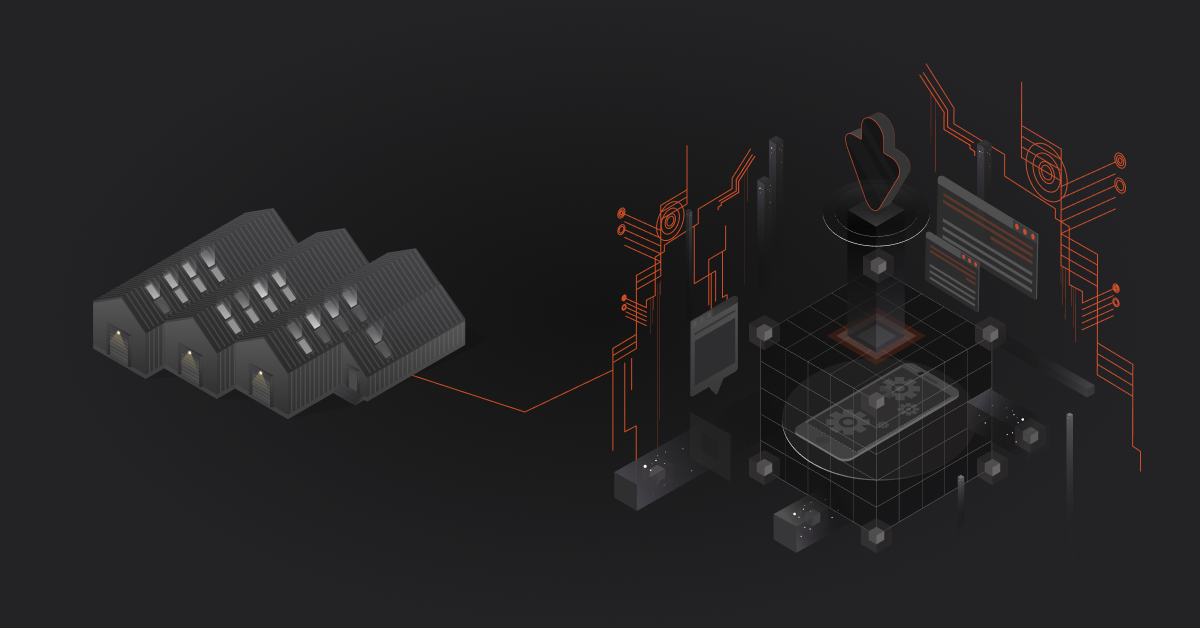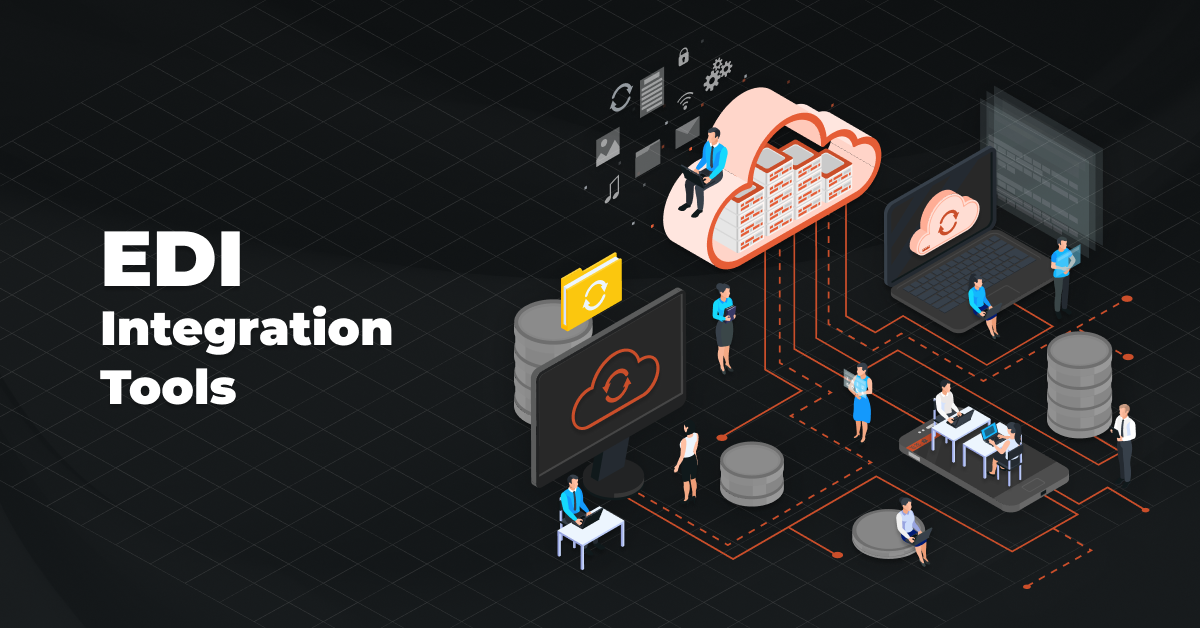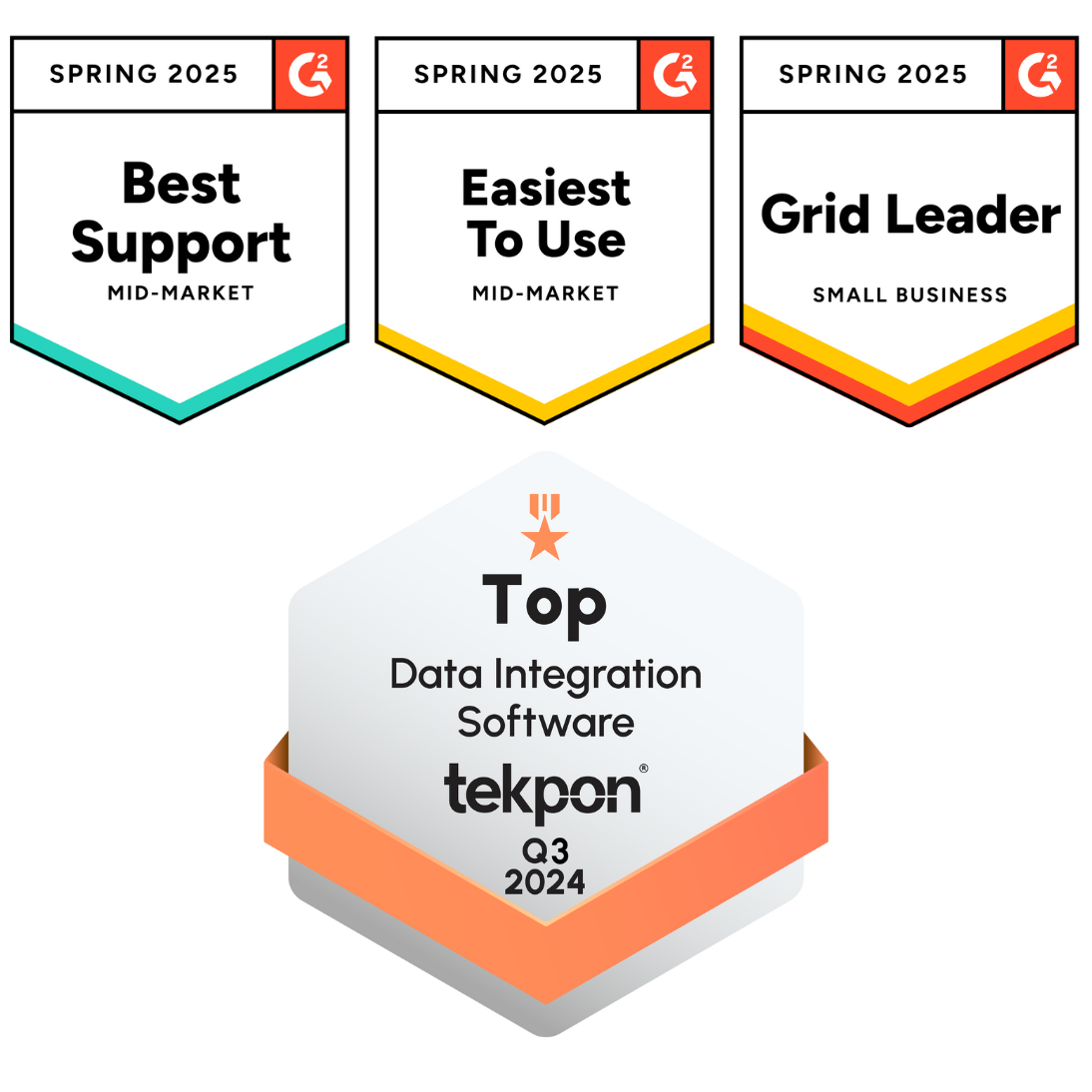B2B EDI Integration refers to the seamless electronic exchange of business documents and information between different companies within a supply chain. These processes are digitized and automated. Instead of relying on paper documents, businesses use standardized electronic formats to exchange information.
This can include purchase orders, invoices, shipping notifications, and other essential documents. Using standardized formats ensures that both the sending and receiving systems can understand and process the data accurately.
How B2B EDI Integration Works
B2B EDI Integration involves the seamless exchange of business documents between partners in a standardized electronic format. Let’s break down how this process works:
Document Types and Standards
- Businesses exchange EDI documents like invoices, purchase orders, shipping notices, and payment remittance advice.
- Different industries and regions often have specific requirements, leading to the use of standards like ANSI X12 (common in the U.S.), EDIFACT (predominant in Europe and Asia), and UBL (Universal Business Language).
Choosing the Right Standard
Selecting the appropriate EDI standard is crucial for effective communication and to prevent human errors. The choice depends on industry practices and the locations of the business partners.

Free Resource: The State of Epicor ERP Integrations (2025)
See how Epicor users are strategically integrating their ERP using DCKAP Integrator.
Download PDFJust click to get the resource. No email needed!
EDI Transmission Methods
Electronic data transmission is key and the choice depends upon various factors.
- Direct EDI: Partners communicate directly using protocols like AS2, FTPS, or SFTP.
- EDI VANs (Value-Added Networks): Third-party intermediaries facilitating secure data exchange between partners.
- EDI Web Services: Leveraging web technologies such as SOAP and REST for internet-based data exchange.
Ensuring Secure Transmission
Security is a must in EDI. Direct EDI employs secure protocols, VANs provide a secure environment, and EDI web services use encryption methods to safeguard data during transmission.
EDI Integration Solutions
Choosing the right EDI integration solution is critical:
- In-house EDI Solutions: Developing and maintaining an internal EDI system, requiring dedicated resources.
- Managed EDI Services: Outsourcing EDI requirements to a third-party provider, who oversees the entire process.
- Cloud-based EDI Solutions: Utilizing cloud technology for flexibility and scalability in accessing EDI services.
Integration and Translation
- Modern Businesses integrate their internal systems (like ERP systems) to facilitate seamless communication.
- Documents are translated into the agreed-upon EDI standard, ensuring compatibility between systems.
Automation and Acknowledgments
- Automated processes handle the exchange, reducing manual processes and speeding up transactions.
- Acknowledgment messages confirm successful document receipt and processing, contributing to transparency.
Efficiency Improvement
The overall aim is to enhance operational efficiency by automating and standardizing the exchange of business information, reducing errors, and accelerating transactions in the B2B supply chain processes.
Also Read: Sage 100 EDI Integration Explained [+ Top 5 Solutions]
Common Documents Exchanged via EDI in B2B Transactions
When two businesses integrate via EDI, the heart of the exchange lies in the documents. These aren’t just digital files, they’re standardized formats that speak the same language across systems, enabling smooth communication.
Here’s a list of the most commonly exchanged EDI documents for manufacturers and distributors:
| Document Name | EDI Standard Code | Purpose |
| Purchase Order | EDI 850 | Sent by the buyer to place an order with a supplier |
| Invoice | EDI 810 | Sent by the seller to request payment for shipped goods |
| Advance Ship Notice (ASN) | EDI 856 | Sent by the seller to inform the buyer before the order is shipped |
| Purchase Order Acknowledgment | EDI 855 | Confirms receipt and acceptance of a purchase order |
| Product Catalog | EDI 832 | Shares updated product and pricing info with trading partners |
| Inventory Inquiry/Advice | EDI 846 | Shares real-time inventory availability |
| Shipping Schedule | EDI 862 | Provides delivery or shipping dates for orders |
| Remittance Advice | EDI 820 | Details the payment being made |
| Request for Quotation | EDI 840 | Requests pricing and availability for specific goods |
These are just the most commonly used ones. However, documents can vary from business to business. Most U.S.-based businesses use ANSI X12 as the EDI standard, while EDIFACT is more common in other countries. Many EDI service providers (and integrators) can translate between these standards based on the trading partner’s location.
Step-by-Step Guide To B2B EDI Integration
Integrating EDI into your operations isn’t just about sending documents electronically but about embedding EDI into your existing systems so transactions flow automatically, from your ERP to your trading partner’s system, and vice versa. For manufacturers and distributors, this means your inventory, orders, shipping, invoicing, and payments all move in sync without manual entry.
Here’s how you can get started:
Step 1: Connect Your ERP, WMS, and Other Core Systems
Your first job is to connect your internal systems (like ERP, WMS, accounting software) with your EDI platform. This is typically done using:
- APIs or connectors (e.g., NetSuite API, SAP BAPI, Acumatica Web Services)
- Flat files (CSV/XML/JSON) if APIs aren’t available
- Middleware or integration platforms that sit between your systems and EDI
This ensures that any data you generate like a purchase order from NetSuite or an invoice from QuickBooks is automatically converted into an EDI format (like 850 or 810).
For example:
- A purchase order created in your ERP automatically triggers an EDI 850 document.
- An advance ship notice (EDI 856) can be generated from your WMS once packing is done.
- An invoice (EDI 810) is auto-created after goods are shipped and posted in your accounting system.
Step 2: Data Mapping and Translation
This is the most technical piece, but crucial. Every ERP or internal system stores data differently. EDI has its own standardized format. So, you need mapping rules to convert:
- Your ERP’s invoice fields → EDI 810 format
- Your warehouse’s shipping data → EDI 856 format
- Your partner’s EDI 850 → a readable PO in your system
Most modern EDI platforms or iPaaS tools (like DCKAP Integrator, Cleo Integration Cloud, or SPS Commerce) handle this mapping and translation for you.
Step 3: Configure Communication with Trading Partners
Once your systems are connected internally, the next step is to establish a communication layer with your trading partners. This is how the EDI documents get exchanged securely.
Common methods include:
- AS2 – Secure peer-to-peer communication over HTTPS
- SFTP – File-based transfer over a secure connection
- VANs (Value-Added Networks) – Hosted networks that manage document flow for you
- APIs – Used when both systems support direct API communication (rare in traditional EDI setups)
So if your trading partner prefers AS2 while your system is SFTP-based, your EDI platform acts as the translator and bridge, ensuring everyone gets what they need in the format and channel they prefer.
Step 4: Enable Real-Time or Scheduled Automation
With the integration in place, your EDI solution can now automate the full document cycle:
- POs go out automatically when orders are created
- Ship notices are triggered when items are picked/packed
- Invoices are sent the moment shipping is confirmed
This closes the loop between your internal systems and your partner’s, enabling:
- Just-in-time inventory
- Faster order-to-cash cycles
- Fewer shipment disputes or billing delays
Step 5: Monitor, Validate, and Resolve Errors Quickly
A good EDI integration gives you a dashboard to monitor document flow and fix issues fast:
- Missing PO numbers
- Price mismatches
- ASN delays
The system should also provide error notifications and resubmission capabilities so you can act before your partner even calls you.
This kind of integration isn’t just for large enterprises anymore. Even mid-sized manufacturers and distributors are doing this using cloud-based platforms or integration solutions that make it all manageable without hiring a huge IT team.
Importance of EDI in B2B Transactions
Electronic Data Interchange (EDI) holds significant importance in B2B transactions, and its role is poised to become even more critical in future supply chains.
Here are the importance of EDI in B2B transactions:
1. Foundation for Document Exchange
EDI serves as the foundational technology for the electronic exchange of business documents between trading partners. It streamlines communication and facilitates the smooth flow of information across the supply chain.
2. Support for Emerging Technologies
In the future, EDI is expected to be the core document exchange capability supporting innovations like the Internet of Things (IoT), blockchain, and artificial intelligence (AI). This adaptability positions EDI as a key enabler for businesses looking to integrate these technologies into their operations.
3. IoT Integration for Real-time Visibility
EDI in the future will incorporate IoT sensors into shipments, enhancing package condition visibility in near real-time. This integration allows for constant monitoring of the shipment’s status, contributing to improved decision-making and responsiveness to potential problems like damaged goods.
4. Blockchain for Transparency and Dispute Resolution
The incorporation of blockchain technology into Shipping EDI information flows for shipments ensures a shared version of the truth. This shared and immutable record can be very important in quickly resolving and even avoiding chargeback disputes. The transparency provided by blockchain enhances trust and accountability in B2B processes.
5. AI Agents for Intelligent Monitoring
Future EDI will include AI agents that actively monitor relevant events and information connected to shipments. These AI agents can identify non-compliant events, enabling proactive management of issues. Additionally, they can assess the need for reshipment, analyze the most efficient source of replacement, initiate new shipments, and facilitate authorized returns.
6. Proactive Supply Chain Management
The combination of IoT, blockchain, and AI with EDI creates a comprehensive system for proactive supply chain management. This integration allows businesses to not only react to events but also predict and prevent potential disruptions, leading to more efficient and reliable B2B transactions.
7. Efficiency and Cost Savings
The streamlined and automated nature of EDI, coupled with the integration of advanced technologies, contributes to overall efficiency in B2B transactions. This efficiency leads to cost savings, reduced manual errors, and improved operational processes.
Also read: EDI Integration with ERP Explained [+ Types, Benefits & Challenges]
Benefits of EDI/B2B Integration in eCommerce
Here are the benefits of B2B EDI Integration
Streamlining Order Processing and Fulfillment: Automation through EDI streamlines the exchange of information, such as purchase orders and invoices, leading to a simpler and faster order-to-fulfillment cycle.
Strengthening Supply-Chain Visibility and Management: EDI/B2B solutions provide end-to-end visibility into supply chain activities, allowing businesses to monitor stock, track shipment statuses, and predict customer demand. This enhances coordination and reduces lead times.
Facilitating Real-time Communication and Data Exchange: EDI enables real-time communication and information exchange using different formats, leading to quicker decision-making and faster responses to customer queries.
Bolstering Efficiency and Productivity: ecommerce automation and integration boost efficiency by minimizing manual tasks, reducing errors, eliminating bottlenecks, and allowing personnel to focus on higher-level, revenue-generating work.
Improving Customer Servicing and Satisfaction: Faster processing, accurate invoicing, and timely shipment notifications provided by EDI/B2B integration contribute to improved customer servicing and increased customer experience.
Enhancing Data Accuracy and Reducing Errors: EDI/B2B solutions eliminate the need for manual data entry, reducing errors and avoiding costly mistakes that can lead to delays and financial losses.
Automating Business Processes: eCommerce automation, facilitated by EDI, minimizes human intervention in various processes such as order management, inventory management, and invoicing, consolidating and speeding up workflows.
Providing Seamless Collaboration: EDI/B2B solutions enable better and faster communication and collaboration among trading partners. Standardized protocols and document formats facilitate easy access and connections with distributors, suppliers, and other stakeholders, fostering effective supply chain management.
Enabling Scalability and Flexibility in Business Operations: Integration solutions allow businesses with EDI/B2B capabilities to grow and pivot their operations seamlessly. They can easily onboard new partners and systems, adapting to changing market demands.
Supporting Compliance with Industry Standards and Regulations: Standardized document formats and communication protocols in EDI ensure compliance with industry regulations, such as the Health Insurance Portability and Accountability Act (HIPAA) and Global Standards. This reduces the risk of penalties and fees, enhancing business reputation.
Also read: Epicor EDI Integration Explained
Challenges and Solutions of B2B EDI Integration
Here are the challenges of B2B EDI Integration
Initial Setup and Investment
Challenge: Integrating B2B EDI often requires a significant initial investment. This includes expenses related to infrastructure, software, and skilled personnel for the setup and maintenance of EDI operations.
Solution: Organizations need to carefully plan and budget for the upfront costs, considering the long-term benefits and efficiencies gained through EDI integration.
Complexity and Compatibility
Challenge: The existence of multiple EDI standards, formats, and protocols can introduce complexity when establishing and maintaining connections with various partners. Compatibility issues may arise due to differences in technology requirements.
Solution: Standardization efforts within the industry can help reduce complexity. Implementing solutions that support multiple standards and ensuring clear communication with partners about compatibility requirements are essential.
Security and Data Privacy
Challenge: The exchange of sensitive business information in EDI transactions raises concerns about data integrity, security, and privacy. Meeting regulatory requirements, especially in highly regulated industries or across borders, adds complexity to ensuring secure data transfer.
Solution: Implement robust security measures, such as encryption and secure data transmission protocols. Compliance with industry regulations and standards, along with clear data privacy policies, is crucial. Regular audits can help ensure ongoing security.
Partner Onboarding and Adoption
Challenge: Onboarding new trading partners to the EDI system and ensuring widespread adoption can be challenging. Partners may vary in their level of EDI readiness, requiring additional effort and resources for education and integration.
Solution: Provide comprehensive training and support to partners during the onboarding process. Establish clear communication channels and documentation to facilitate smooth integration.
System Integration with Existing Infrastructure
Challenge: Integrating EDI with existing systems and infrastructure within an organization can be complex. Legacy systems may not be inherently compatible, leading to integration challenges.
Solution: Invest in integration solutions that bridge the gap between EDI and existing systems. Conduct a thorough analysis of the organization’s technology landscape and plan for seamless integration with minimal disruptions.
Change Management
Challenge: Implementing B2B EDI often requires a shift in processes and workflows, which can face resistance from employees accustomed to traditional methods.
Solution: Prioritize change management efforts, including training programs, communication strategies, and involving key stakeholders from the early stages of integration. Highlight the benefits of EDI to encourage adoption.
System Downtime and Reliability
Challenge: EDI systems must be reliable to ensure uninterrupted business operations. Downtime or system failures can disrupt the flow of critical business information.
Solution: Implement robust backup and recovery measures. Choose reliable EDI service providers and regularly test the system’s reliability to minimize the risk of downtime.
Navigating these challenges is essential for organizations aiming to harness the benefits of B2B EDI integration in their business processes and relationships.
What to Expect From an EDI Service Provider
Now with so many EDI tools, standards, and protocols, and hundreds of other things to consider, it could be a daunting task to pick the right tool. Plus, not all EDI providers are built the same and if you’re a manufacturer or distributor, you don’t want to be stuck with a black-box solution that makes you wait days for support.
Here are a few key things to look for:
1. Support for All Document Types
Your provider should support a wide range of EDI documents especially the ones you’ll use most (850, 810, 856, 855, 846). If they can’t, that’s a red flag.
2. Pre-Built Integrations with Your Systems
Whether you’re using SAP, Oracle NetSuite, Acumatica, Epicor, or QuickBooks, your provider should offer pre-built or custom connectors so you’re not forced into manual uploads or patchy middleware.
3. Transparent Error Management
Make sure the platform offers real-time visibility into:
- Transaction status (sent, received, failed)
- Error messages with detailed logs
- Easy options to reprocess failed transactions
4. Scalability and Partner Flexibility
Your EDI solution should be able to:
- Onboard new trading partners fast
- Handle changing compliance rules
- Scale with you as your order volume grows
5. Human-Centered Support
You want a provider that understands your industry. Not just generic tech support, but people who can help troubleshoot based on real-world distribution or manufacturing scenarios.
Top B2B EDI Integration Tool For Manufacturers and Distributors – DCKAP Integrator
DCKAP Integrator is a powerful EDI integration tool for distributors that excels in advanced data mapping and transformation, ensuring precise translation and compatibility between B2B EDI formats. This capability leads to enhanced integration, reduced errors, and a seamless flow of data between systems.
The solution’s automated workflow empowers organizations to effortlessly plan and execute complex B2B EDI integration procedures. By streamlining business processes and reducing the manual management of intricate procedures, DCKAP Integrator enhances overall productivity.
Real-time integration monitoring capabilities provided by DCKAP Integrator allow businesses to observe B2B EDI transactions, identify bottlenecks, and proactively address issues. This real-time visibility contributes to improved decision-making and operational efficiency.
DCKAP Integrator ensures data integrity with robust exception handling. In the event of discrepancies or failed B2B EDI transactions, the system promptly delivers informative messages, facilitating troubleshooting and assuring businesses that accurate data continues to flow seamlessly through their systems.
Book your free demo now to explore advanced data mapping, automated workflow orchestration, real-time monitoring, and robust exception handling. Revolutionize your B2B EDI processes and elevate your business processes.
FAQs
What is B2B Integration?
B2B Integration, or Business-to-Business Integration, is the process of connecting and automating business processes between different companies. They provide a competitive advantage as It involves the exchange of electronic data, such as orders, invoices, and shipping notifications, in a standardized and automated manner.
Which are B2B integration platforms?
Today there are various B2B integration solutions available such as DCKAP Integrator, Jitterbit Harmony, IBM Sterling B2B Integrator, Cleo Integration Cloud, and MuleSoft Anypoint Platform.
How can businesses optimize B2B EDI processes for greater efficiency?
Best practices include thorough planning, clear communication with B2B partners, adherence to EDI standards, robust data mapping, automation of business processes, real-time monitoring, and proactive exception handling to ensure seamless integration.
What role do APIs play in EDI Implementation?
APIs (Application Programming Interfaces) in EDI Implementation enable seamless communication between different software systems. They facilitate the integration of EDI processes with existing business applications, streamlining data exchange.
What distinguishes Web EDI from traditional EDI?
Web EDI is a browser-based solution that allows businesses to engage in electronic data interchange (EDI) without the need for specialized software. It provides a user-friendly interface, making EDI accessible to a broader range of users.
How do businesses choose the right EDI Service Provider?
Choosing the right EDI Service Provider involves considering factors such as industry expertise, scalability, support services, cost-effectiveness, and the ability to meet specific business needs and compliance requirements.
In what ways has EDI improved communication in the business sector?
EDI has improved business communication by enabling faster and more accurate file transfer. It has reduced reliance on paper-based processes, minimized errors, shortened transaction cycles, and enhanced overall efficiency in B2B communication.
Why is a B2B platform essential for efficient EDI integration?
A B2B platform streamlines the entire process of EDI integration by providing a centralized hub for data exchange. It ensures consistency, security, and standardized communication between businesses, simplifying the complexities of B2B transactions.
How does B2B EDI integration fit into the context of global supply chains?
B2B EDI integration plays a crucial role in global supply chains by providing a standardized platform for electronic data exchange. It enhances coordination, visibility, and efficiency in cross-border transactions, supporting seamless collaboration among international partners.
How do businesses choose the appropriate data format for B2B transactions?
Businesses choose data formats based on industry standards, trading partner requirements, and the nature of the information being exchanged. Compatibility and adherence to established formats are crucial for seamless B2B communication.
Can businesses of all sizes gain a competitive edge through B2B EDI integration?
Yes, businesses of all sizes can gain a competitive edge through B2B EDI integration. While larger enterprises often leverage more sophisticated solutions, smaller businesses can benefit from cost-effective and scalable options, ensuring competitiveness in the market.





